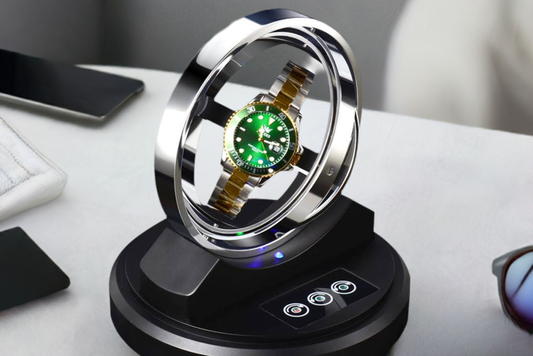Automatic Winding Explained
The Rolex Datejust, an iconic automatic watch, harnesses the wearer's movement to power its intricate mechanisms. This self-winding technology, also known as a perpetual rotor, is a hallmark of luxury watches. The rotor, a half-moon shaped weight, oscillates with the wearer's arm movements, generating energy that is stored in the watch's mainspring. This innovative system eliminates the need for battery replacements, making the Rolex Datejust a reliable and low-maintenance timepiece.
Credit: YouTube Channel - Bob's Watches - Buy \u0026 Sell Rolex
How it Works
The automatic winding mechanism is based on the principle of kinetic energy conversion. As the wearer moves their arm, the rotor oscillates, driving the gears and springs that power the watch. The mainspring, which stores the generated energy, is wound tighter with each movement, ensuring a consistent power supply to the watch's mechanisms. This process is facilitated by a clever system of gears and levers that convert the rotor's oscillations into a rotational force, which is then transmitted to the mainspring.
Efficiency and Accuracy
The efficiency of the automatic winding mechanism is crucial to the watch's accuracy and reliability. Rolex's proprietary technology ensures that the rotor's oscillations are converted into a consistent and precise power supply, resulting in a watch that keeps accurate time. The Datejust's automatic winding mechanism is designed to provide a power reserve of approximately 70 hours, allowing the watch to continue running even when not worn for an extended period.
Manual Winding Basics
While the Rolex Datejust is an automatic watch, there may be instances where manual winding is necessary. This is typically the case when the watch has not been worn for an extended period, and the power reserve has been depleted. Manual winding involves turning the watch's crown clockwise to wind the mainspring directly. This process requires careful attention, as over-winding can damage the watch's mechanisms.
When to Manually Wind
It is recommended to manually wind a Rolex Datejust when:
- The watch has not been worn for an extended period (more than 70 hours).
- The watch has been stored for an extended period without being wound.
- The watch's power reserve is depleted, indicated by a slower or inconsistent timekeeping.
How to Manually Wind
To manually wind a Rolex Datejust, follow these steps:
- Ensure the watch is not worn on the wrist.
- Locate the crown, typically positioned at the 3 o'clock position.
- Unscrew the crown by turning it counterclockwise until it pops out.
- Turn the crown clockwise approximately 30-40 times to fully wind the mainspring.
- Push the crown back in and screw it down by turning it clockwise until it is securely fastened.
By understanding the intricacies of automatic winding and manual winding, Rolex Datejust owners can appreciate the craftsmanship and engineering that goes into creating these iconic timepieces.
How Often to Wind Your Rolex Datejust
The Rolex Datejust is a luxury watch that is known for its precision and durability, but it does require regular maintenance to keep it running accurately. Winding your Rolex Datejust is an essential part of its upkeep, but how often you need to wind it depends on several factors, including how often you wear it and your personal preferences.
Daily Wear
If you wear your Rolex Datejust daily, you'll need to wind it regularly to ensure it keeps accurate time. The watch has a self-winding mechanism, which means it winds itself as you move your arm, but this mechanism is not enough to keep the watch fully wound if you don't wear it regularly. It's recommended to give your Rolex Datejust about 20-30 turns of the crown every morning before wearing it. This will ensure that the watch remains accurate and that the power reserve is maintained.
Occasional Wear
If you only wear your Rolex Datejust occasionally, you may not need to wind it as frequently. The watch has a power reserve of around 70 hours, which means it will continue to run for several days after it's fully wound. However, it's still recommended to wind your Rolex Datejust every week or two to keep it running accurately and to prevent the lubricants in the watch from breaking down due to inactivity. Give the crown about 30-40 turns to fully wind the mainspring.
The Importance of Power Reserve in Rolex Datejust Watches
Rolex Datejust's Power Reserve: How Long It Lasts and Why It Matters
A Rolex Datejust watch, like any other mechanical watch, relies on a power reserve to maintain its timekeeping accuracy. The power reserve is the amount of time a watch can continue to run without being wound, ensuring that the watch remains accurate and functional. The power reserve of a Rolex Datejust watch typically lasts around 70 hours, depending on the specific model and usage.
Maintaining Consistency: The Role of Winding in Preserving Time Accuracy
Winding a Rolex Datejust watch is crucial to maintaining its timekeeping accuracy. The watch's mechanical movement relies on the mainspring, which stores energy generated by the wearer's movements or manual winding. When the mainspring is fully wound, the watch's power reserve is at its maximum, ensuring that the watch remains accurate for an extended period.
Why Winding Matters
Regular winding is essential to maintain the watch's power reserve and ensure consistent timekeeping. If the watch is not wound regularly, the power reserve will deplete, and the watch's accuracy may suffer. This is particularly important for Rolex Datejust watches, which are known for their precision and reliability.
Tips for Winding Your Rolex Datejust
To maintain the power reserve of your Rolex Datejust watch, it is recommended to wind it regularly, ideally every day or every other day, depending on your usage. Here are some tips for winding your Rolex Datejust:
- Wind your watch in a clockwise direction until you feel resistance.
- Avoid over-winding, as this can damage the mainspring.
- Wind your watch at the same time every day to maintain consistency.
- If you do not wear your watch regularly, consider storing it in a watch winder to maintain the power reserve.
The Correct Way to Wind a Rolex Datejust
Step-by-Step Winding Technique
Winding a Rolex Datejust requires a gentle and deliberate approach to ensure the longevity of the watch. Here's a step-by-step guide:
1. Hold the Watch Correctly
Hold the watch in your non-dominant hand, with the crown facing upwards. Make sure your hand is not obstructing the crown or the watch's movement.
2. Locate the Crown
Identify the screw-down crown, which is typically located on the right side of the watch case. The crown is used to wind the watch, set the date, and adjust the time.
3. Unscrew the Crown
To wind the watch, you need to unscrew the crown. Turn the crown counterclockwise until it comes loose. Be careful not to force the crown, as this can damage the watch's mechanism.
4. Wind the Watch
Once the crown is unscrewed, turn it clockwise to wind the watch. You will feel resistance as you turn the crown. Continue winding until you feel a slight decrease in resistance, indicating that the watch is fully wound. Typically, 30-40 turns are sufficient to fully wind the mainspring.
5. Screw Down the Crown
After winding the watch, screw the crown back down to protect the watch from moisture and dust. Make sure the crown is securely tightened to ensure the watch remains water-resistant.
Screw-down Crown Protocol
The screw-down crown is a critical component of the Rolex Datejust's water-resistance system. Here's how to properly use the screw-down crown:
1. Unscrew the Crown
Before winding the watch or setting the date, unscrew the crown by turning it counterclockwise.
2. Perform the Desired Action
Wind the watch or set the date as needed.
3. Screw Down the Crown
After completing the desired action, screw the crown back down by turning it clockwise. Make sure the crown is securely tightened to ensure the watch remains water-resistant.
4. Check the Crown
Regularly check the crown to ensure it is securely tightened. A loose crown can compromise the watch's water-resistance and allow moisture to enter the watch case.
By following these steps and protocols, you can ensure your Rolex Datejust remains accurate, reliable, and protected from the elements. Remember to wind your watch regularly to maintain its power reserve and keep it running smoothly.
Benefits and Considerations: When a Watch Winder Becomes a Necessity
A Rolex Datejust, like any other mechanical watch, requires regular winding to maintain its accuracy and prolong its lifespan. If you own a Rolex Datejust, you may wonder whether a watch winder is necessary for its proper maintenance. The answer lies in understanding the benefits and considerations of using a watch winder.
Benefits of a Watch Winder
A watch winder provides several benefits for your Rolex Datejust, including:
- Accuracy: A watch winder ensures that your watch remains accurate by keeping it wound, which is especially important for mechanical watches that rely on a mainspring to power their movements.
- Convenience: A watch winder eliminates the need for manual winding, which can be time-consuming and may lead to inconsistent winding patterns.
- Protection: A watch winder helps protect your watch from damage caused by manual winding, such as over-winding or under-winding.
- Preservation: A watch winder can help preserve the longevity of your watch by reducing the wear and tear on its mechanical components.
Considerations for Choosing a Watch Winder
When selecting a watch winder for your Rolex Datejust, consider the following factors:
- Compatibility: Ensure that the watch winder is compatible with your Rolex Datejust's specific model and movement type.
- Features: Look for features such as multiple winding modes, directional control, and adjustable torque settings to accommodate your watch's specific needs.
- Quality: Choose a high-quality watch winder from a reputable manufacturer to ensure reliability and durability.
Selecting the Right Watch Winder for Your Rolex Datejust
When selecting a watch winder for your Rolex Datejust, consider the following options:
- Single Watch Winder: A single watch winder is suitable for those who own only one watch. These winders are compact and affordable, with prices ranging from $50 to $200. Popular brands include WOLF and Versa.
- Multi-Watch Winder: A multi-watch winder is ideal for collectors or those who own multiple watches. These winders can accommodate two or more watches and are priced between $200 to $1,000. Brands like Orbita and Heiden offer high-quality multi-watch winders.
- Luxury Watch Winder: Luxury watch winders offer advanced features such as touchscreen controls, GPS synchronization, and high-quality materials. These winders are priced between $1,000 to $5,000. Brands like Buben & Zorweg and SwissKubiK cater to the luxury market.
In conclusion, a watch winder is a necessary accessory for any Rolex Datejust owner who wants to ensure the accuracy, convenience, and protection of their timepiece. By understanding the benefits and considerations of using a watch winder, you can select the right one for your needs and enjoy the peace of mind that comes with knowing your watch is properly maintained.
Myth: Overwinding Damages the Watch
Debunking the Myth
The notion that overwinding a watch can cause damage is a common misconception. In reality, modern automatic watches, including the iconic Rolex Datejust, are designed with safety mechanisms to prevent overwinding. These mechanisms ensure that the mainspring is not subjected to excessive tension, which could potentially cause damage to the watch's internal components.
Fact: The Safe Zone for Winding
The safe zone for winding an automatic watch lies in the optimal power reserve range. For most watches, this range is between 30% to 80% of the total power reserve. Winding the watch within this zone ensures that the mainspring is not overstressed, reducing the risk of damage.
Shaking vs. Winding: The Right Approach for Older Models
For older automatic watches, especially those without modern safety mechanisms, a gentle shaking motion can be a more effective way to wind the watch than manual winding. This approach helps to avoid putting excessive stress on the mainspring and reduces the risk of damage.
In conclusion, while it is essential to wind an automatic watch regularly to maintain its accuracy and power reserve, it is equally important to understand the safe zone for winding and to avoid overwinding. By doing so, watch enthusiasts can ensure the longevity and optimal performance of their timepieces.
Servicing Schedule: Why every 10 years is a benchmark
The recommended servicing schedule for a Rolex watch, including the Datejust model, is every 10 years. This benchmark is set by Rolex to ensure the watch remains accurate and in good working condition. The 10-year mark is significant because it allows for a thorough inspection and maintenance of the watch's internal mechanisms, including the lubrication of gears and the replacement of worn-out parts.
Lubrication and Gear Health: How winding impacts internal mechanics
Winding a Rolex watch, including the Datejust model, plays a crucial role in maintaining the health of its internal mechanics. The winding process helps to distribute lubricants throughout the gear train, reducing friction and wear on the moving parts. This is particularly important for automatic watches like the Datejust, which rely on the wearer's movements to wind the mainspring. If the watch is not worn regularly, the lubricants can break down, leading to increased friction and wear on the gears.
Regular winding also helps to maintain the watch's accuracy and prevent damage to the gear train. When a watch is not wound regularly, the mainspring can become over-wound or under-wound, leading to inaccurate timekeeping and potentially damaging the gear train. By winding the watch regularly, the mainspring is kept at the optimal tension, ensuring the watch remains accurate and the gear train is protected from damage.
In addition to regular winding, Rolex recommends servicing the watch every 10 years to ensure the lubricants are replenished and the gear train is cleaned and inspected. This helps to prevent the buildup of dirt and debris, which can cause friction and wear on the moving parts. By following the recommended servicing schedule and winding the watch regularly, owners can help to extend the life of their Rolex Datejust and ensure it remains in good working condition.
Winding Frequency
The Rolex Datejust is an automatic watch, which means it winds itself using the wearer's movements. However, if the watch is not worn for an extended period, it may require manual winding to maintain its power reserve. The recommended winding frequency for a Rolex Datejust is:
- Daily wear: No manual winding is required, as the watch will wind itself through the wearer's movements.
- Occasional wear (2-3 times a week): Wind the watch every 7-10 days to maintain the power reserve.
- Rare wear (less than 2 times a week): Wind the watch every 5-7 days to maintain the power reserve.
- Storage: Wind the watch before storing it, and then every 2-3 months to maintain the power reserve and prevent damage to the mechanism.
Adjustments
To ensure accurate timekeeping, it's essential to adjust your Rolex Datejust regularly. Here are some tips:
- Adjust the date at midnight, as the date changes automatically.
- Adjust the time by pulling the crown out to the second position (for quick-set models) or the first position (for non-quick-set models).
- Avoid adjusting the date between 10 pm and 2 am, as this can damage the mechanism.
Storage
Proper storage is crucial to maintain the longevity of your Rolex Datejust. Here are some storage tips:
- Store the watch in a cool, dry place away from direct sunlight.
- Avoid storing the watch in a humid environment, as this can cause damage to the mechanism.
- Use a watch winder or a soft cloth to store the watch, as this can help maintain the power reserve and prevent scratches.
Longevity
To ensure the longevity of your Rolex Datejust, it's essential to maintain it regularly. Here are some tips:
- Service the watch every 5-10 years, or as recommended by Rolex.
- Clean the watch regularly using a soft cloth and mild soap.
- Avoid exposing the watch to extreme temperatures, shocks, or magnetism.
Additional Tips
- Avoid winding the watch excessively, as this can cause damage to the mechanism.
- Use the correct winding direction (clockwise) to avoi




